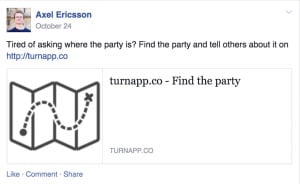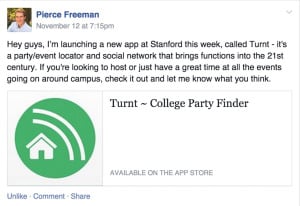In the past six months, three Stanford freshmen have independently created apps and websites that track parties on campus.
Party Brah, Turnapp and Turnt were all introduced to the Stanford student body between mid-October and mid-November through the Stanford Class of 2018 Facebook page. Since then, the Party Brah website has been visited over 30,000 times, and Turnt has over 2,000 downloads from the App Store.
Tyler Weitzman ’18 was the first to publicize his website, Party Brah. His concept for Party Brah arose from his observations of eager freshmen unsure of where to locate campus nightlife when first arriving on The Farm.

“I came up with [Party Brah] the first weekend of parties when I know everybody was talking about the Disorientation Party, and nobody really knew what was actually going on,” he said.
Originally called “Where’s the Party Brah,” this website displayed the location of a single party happening on the evening the user visited the site, as determined by tips sent to an email address listed on the page.
Weitzman said he chose to create a website over an app in order to quickly gauge student interest in a party-tracking tool like Party Brah.
“I wanted to see if people wanted it before I put the time to create a full app,” he said.
Weitzman did not anticipate major success for the website beyond its initial launch.
“There was a huge spike when I first posted about it on Facebook…[but] I thought that it died [after] the initial views on that weekend,” he said. “But then the next weekend, there were suddenly 1,000 page views — I hadn’t posted about it again, but people who heard about it the week before went back to check it again. And that was [an] indication for me that [Party Brah] could work, that it could catch traction.”
Soon after the release of Party Brah, Axel Ericsson ’18 posted about his own party-tracking website on Facebook, Turnapp.
Ericsson had a different approach for the concept of his party-tracking website: using user-generated data to display where the parties on campus are happening. He was similarly inspired by the climate of campus life and conversations around him in forging this approach.
“I was sitting at a dinner table with a few of my friends, then one girl said she knows a girl…with all the Greek letters on her door, and whenever her friends go out to one of the frats or sororities, they circle the Greek letters they went to on the board, so people would know where they went,” Ericsson said. “So, I thought to myself, ‘Wow let’s do a digital version of that — where anyone can have their own board, and they can click on the Greek letters themselves, and then people vote on which of these letter combinations is the best to go to.’”
It only took one night to build the site.
“The interesting thing was, this was the same night as [Weitzman] posted his website on the [Stanford Class of 2018] Facebook group, and people started using that,” he said.
Two weeks later, Ericsson decided to post his own promotional introduction to Turnapp on the Class of 2018 Facebook group.

Both curious and intrigued after reading this post, Weitzman decided to reach out to Ericsson about their similar websites.
“[After] I met with him, I understood that he had thought of the idea separately; even though he knew of my website and launched it after mine, he wasn’t stealing the idea or anything,” Weitzman said.
Seeing such similarities, the two programmers decided to combine their efforts and collaborate on a single party-tracking website, Party Brah.
“I knew that [Ericsson] was passionate and believed in this idea because he had gone through the trouble of creating a competing website himself, so he was clearly interested in the field and believed that it was worthwhile,” Weitzman said.
Ericsson developed a new moderator system and design for the Party Brah website, which now can list multiple parties. Together, they are working on creating a native app as well as expanding Party Brah to colleges beyond Stanford.
As this partnership formed, Pierce Freeman ’18 was preparing to announce the impending launch of his party-tracking app, Turnt, on Facebook.
Turnt is a social networking application that specializes in finding events going on around campus. It is currently party-focused, serving as a centralized repository for students to visually see which parties their friends and peers are going to on a map. It eventually intends to expand to include other types of events on campus.
Freeman came up with the idea for Turnt this past summer with high school friend Matt Jacobs while discussing a realization drawn from their social experiences in high school.
“If your friends are going out to do something, unfortunately it’s just not really natural for our generation to actively text people and invite them to places,” Freeman said. “We were thinking that if it’s a similar case at all in college…then it would be really advantageous to have a central application where people could post what they’re doing, invite their friends or invite [the] entire campus to these events, so people who might not have contacts or friends that go out can [still] have a good time.”

Unlike Party Brah, Turnt was conceived as an app. Freeman said he favored the app format for its mobility and geolocation features.
Turnt also has plans to broaden its reach beyond Stanford and Santa Clara University, where Jacobs currently attends school.
“We’re also potentially looking at expanding to other colleges and employing the use of college reps that we trust at other schools. We think that’s the best way to go, because it’s a lot easier to get people to use something if their friends are already using it.”
When asked to comment on Party Brah, Freeman noted, “[Weitzman] actually mentioned it to me a couple days ago, so I checked it out. Prior to that I really wasn’t aware of the website.”
As far as competition, Freeman said, “I don’t think competition is necessarily a bad thing, but as the products stand, they’re doing different things right now.”
On the same topic of competition, Ericsson said, “Developing an idea and making it something that’s really big and widespread and that a lot of people use takes years of work. If a few people start doing the same thing in the beginning, it’s really not that big of a disaster for any of them.”
According to Ericsson, the creation of three party-tracking tools within just a month is a testament to the idea’s staying power.
“What’s interesting is that, in the course of four weeks, three people have separately started doing the same kind of project,” he said. “That tells you a lot about the project itself, that it might actually be one of those things that takes off…it feels like one of those things that should just be there — there should be a website or an app, or both, that lets you find parties, especially at colleges. So, it’s really sort of a mystery as to why there isn’t such a thing already.”
The appealing quality of party-tracking systems is the efficiency they offer, which is especially attractive to a student body concerned with time management and productivity. Furthermore, the availability of reliable information through the reputable app or website, as opposed to word of mouth, gives people the reassuring sense of being well-informed.
As Weitzman puts it, “socially, people like to be in the loop.”
On the value of party tracking, Weitzman said, “It’s a big campus and people can’t bike around drunk, so better [to] know whether there’s a party at Kappa Alpha before you walk up the hill, right?”
Contact Rebecca Aydin at raydin ‘at’ stanford.edu.